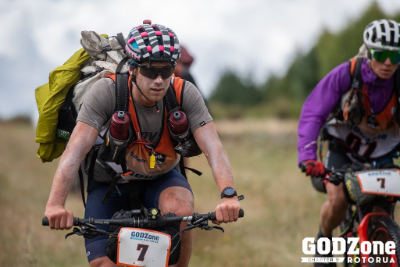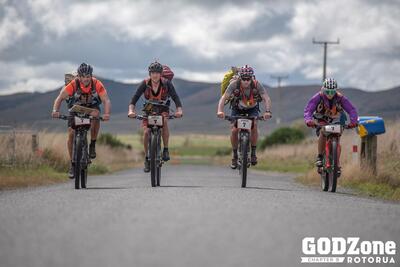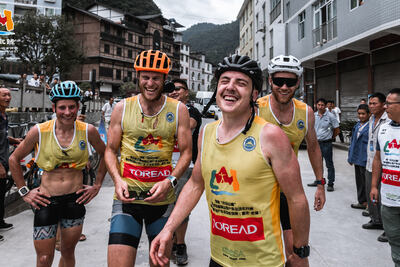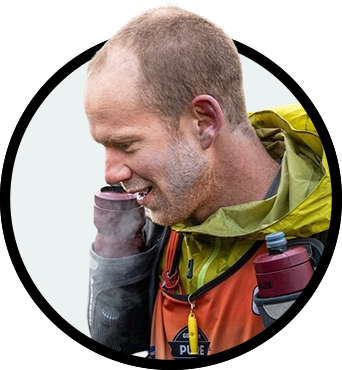Much of my early years training for endurance races were spent becoming tuned into my own body and mind. I spent a lot of time honing in on what worked for me personally in terms of training, pacing, fueling and motivating myself to perform in IRONMAN and Coast To Coast races.
As a result, I saw improvements in my performance and became better at understanding how I responded to different stimuli during this journey of 'self-discovery'.
I believe that many of the best endurance athletes are successful because they know themselves better than most. They know what works best for them in training and they know how to execute on race day according to their own unique attributes.
So, what happens when an athlete who's been focused for years on maximising their performance as an individual makes the transition to competing in a team format?
In 2009, I flew to China to take part in a four-day adventure race called the Wulong Mountain Quest. The team format was fairly typical of adventure racing and included three male and one female athlete. There were many stressful decisions being made under high levels of fatigue which was a baptism of fire for me in terms of team racing. Since then, I've competed in a wide range of team formats across adventure racing, cycling and now sailing.
With the benefit of these experiences, I've shared five things I've learned about achieving success in a team environment (be that in sport, work or life)...
1. Who are you?
I think the first step when looking to enhance your performance in a team environment is spending time reflecting and developing a strong sense of who you are and what you bring to the team.
When I came into a team for the first time back in 2009, I knew I was bringing youthful enthusiasm, a high level of physical strength and fitness, determination and competitiveness that would make me reliable and highly likely to keep going to the finish.
However, I knew I lacked experience in a team and needed to be led by my teammates around key decisions and strategy. I wasn’t familiar with China and the intricacies specific to racing there, I didn’t know how best to support my teammates when required, nor how to receive or ask for support when I needed it.

2. Who are your teammates?
The next step would be to spend time learning about and understanding your teammates. What values, strengths and weaknesses do each of them possess? Do they contrast or compliment your own? Being aware of what each of them brings will help you build a picture of the team and how you can look to exploit your respective strengths and bring awareness to your vulnerabilities.
I remember receiving a phone call in 2013 from the current world adventure racing team captain Nathan Faavae (Team Seagate) inviting me to race in Brazil that week.
With very little time to make a decision, I quickly did a mental scan of what I could offer and what qualities and skillsets he and the other two teammates, Sophie and Trevor, possessed. They had good combined experience in expedition racing (non-stop format), were good navigators and were well organised. I had minimal expedition racing experience, couldn’t navigate and had a matter of days to get organised and fly to Brazil.
Thankfully, where I felt most vulnerable and likely to leave gaps in the team happened to be areas that would be quickly filled by the skillsets of my teammates. I was on a flight a few days later.
3. Who are we?
The final important step when building a picture of the team is then considering who you are collectively together. What do you represent as one unified force?
Considering the first two steps, this should become fairly clear, but often it takes a few training and competitive experiences to truly understand who you are as one.
We often think, behave and act differently under stress, pressure and fatigue, so often the race settings are where you will help deepen your awareness and understanding of the team.
One of the most successful adventure racing teams I've belonged to won every major race in China in 2019 after failing to achieve our goals the year prior. We had a number of setbacks in 2018 which taught us a lot about ourselves and how we could function better together. These experiences no doubt contributed greatly to our success a year later.

One teammate would disintegrate in the heat, but once we understood this, we knew how to better manage him in the middle of the day when it was particularly hot, by carrying some of his gear and reminding him to hydrate and cool himself. Whenever conditions were cooler, he would always be a major asset and often the strongest member of our team. The key was to know when to hold him back and when to unleash him!
4. Ego (or lack of) for the greater good
Reflecting again on the race I did with Team Seagate in Brazil in 2013, I remember being horrendously intimidated by the idea of racing with such proven performers. Nathan in particular had long been a hero of mine and his ability to stay strong, focused and efficient for more than a week of non-stop racing made him almost super-human in my eyes. My biggest fear would be letting him down, showing my weaknesses and needing help.
So, it was with utter surprise when barely six hours into the race after asking how I was feeling (to which I quickly responded that I was feeling good), he passed me his backpack to carry for him while he managed his way through a period of low energy and fatigue.
It suddenly dawned on me that this man wasn’t a multiple world champion because he had no weaknesses. He was after all a human being and we all have weaknesses. He was a world champion because he had no ego.
He knew through his vast adventure racing experience that in that moment, the best interests of the team and our ability to keep moving quickly involved shifting the burden from the weaker athlete to the stronger one. From that moment on, I knew I’d need to always make sure I did what was best for the team, even if it meant putting my ego to one side and asking for help. Keeping communication lines open and remaining honest with the team will always help ensure you’re performing as well as each circumstance allows.

In my latest transition into sailing and becoming a member of Emirates Team New Zealand in their quest to defend the America’s Cup in 2024, I've once again been reminded of the magic that happens within a team when we place our ego to the side.
Within this team there are more than 100 people that I call teammates. They're electricians, lawyers, accountants, builders, sail makers, film makers, sailors, and ‘cyclors' (which is my role in the team - I'm basically a grinder that uses leg power rather than arms).
Every lunchtime we eat together on site and there's no status involved. I might sit and eat with the hydraulics guy, the chef, the design engineer and the boat builder. We see each other as equal parts of a team that shares a common goal. Each of us can only do our job if the people around us are doing theirs.
When status doesn’t exist and a common goal is the focal point, it can be a tremendously unifying experience. Any sports team, work place and other group or team environment can benefit from this approach.
5. Team-centric
To summarise what I have learned as part of numerous successful teams across a variety of sports, the move from solo racing to team racing requires a shift in focus and awareness from what is best for self into what is best for the team.
If I'm racing solo and want to get a mental advantage over my competition, I’d often get in front of them and control the race. To me, this would provoke a sense of superiority and hopefully force my competitor to feel inferior.
For the same reason, when I was feeling strong in a team adventure racing situation, I’d often place myself at the back so a teammate who might be struggling at the time could benefit from the psychology of being in front.
The former example being an individual tactic that is flipped upside down in the latter example where the best interests of the team are the priority.
As is often said in adventure racing:
We can only ever move as fast as our slowest teammate.
So, the challenge (and often the fun) is in the continuous consideration of how best to move the slowest team member most efficiently. The best teammates I've had have always placed the best interests of the team ahead of their own. That's ultimately where any team - in sport, work or life - will likely achieve and perform closest to their potential.
